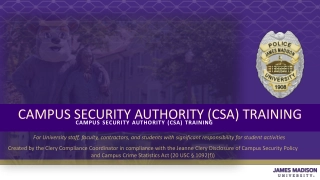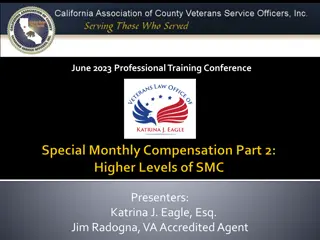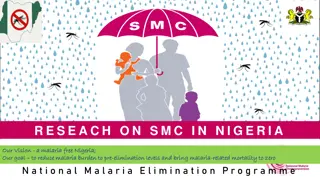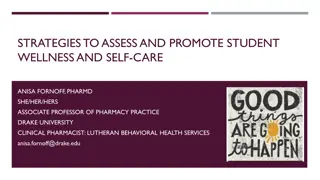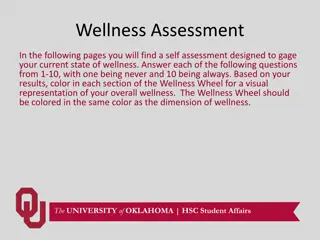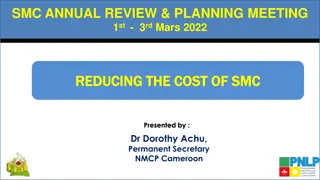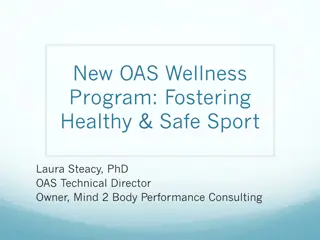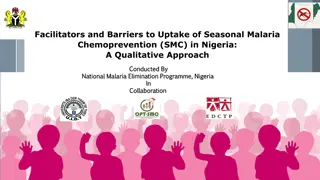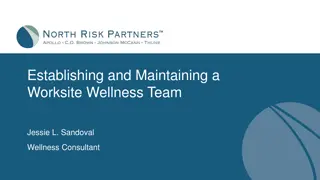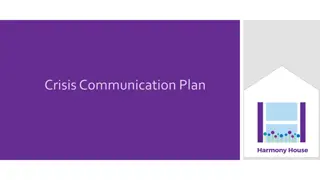SMC Crisis Prevention Team: Ensuring Campus Safety and Wellness
The SMC Crisis Prevention Team, established in 2007 after the incident at Virginia Tech, is dedicated to enhancing campus safety through a proactive and collaborative approach. Comprising 13 members from various departments, the team focuses on preventing, identifying, assessing, intervening, and managing potential threats. By providing training, utilizing threat assessment tools, and actively participating in conferences, the team prioritizes prevention and maintaining a secure environment. Learn about when to refer a student for concerning behavior, including signs of self-harm, possession of weapons, and the importance of trusting instincts while distinguishing between normal and abnormal behavior.
Download Presentation

Please find below an Image/Link to download the presentation.
The content on the website is provided AS IS for your information and personal use only. It may not be sold, licensed, or shared on other websites without obtaining consent from the author. Download presentation by click this link. If you encounter any issues during the download, it is possible that the publisher has removed the file from their server.
E N D
Presentation Transcript
The SMC Crisis Prevention TEAM PRESENTATION TO SANTA MONICA COLLEGE DEPARTMENT CHAIRS AND COORDINATORS NOV.06, 2015
History, Mission and Purpose of SMC Crisis Prevention Team History: Team formed in fall 2007 in response to incident at Virginia Tech Mission/Purpose: To improve campus safety Uses a proactive, collaborative approach Seeks to PREVENT, IDENTIFY, ASSESS, INTERVENE and MANAGE situations that may pose a threat Goal of team is PREVENTION and connecting the dots
Crisis Prevention Team Structure and Process 13 person team Members include representatives from: Campus Police, Student Judicial Affairs and Discipline, Psych Services , Ombuds Office, Counseling, Health Services, Academic Affairs, DSPS, International Students, Human Resources, Title IX team and Legal Counsel Will soon be adding a Case Manager to the team Meet twice monthly (or more often if needed) An average of 20 cases are discussed per meeting Provide training to faculty and staff Team members belong to NABITA (National Behavioral Intervention Team Association) Team members use NABITA and SIVRA 35 Threat Assessment tools when appropriate Various Team members regularly participate in relevant professional conferences
When should I Refer a Student? (Signs of Worrisome Behavior) Inappropriate Emails Emails that are threatening, contain overly violent themes, display suicidal ideation or severe depression, or are overly personal, etc. Inappropriate or Bizarre Behavior Yelling or screaming in class or public space Inappropriate comments (comments that are out of context, violent, sexual, display paranoid thinking, etc.) Mention of Thoughts or Gestures of Self Harm or Harm to Others Mention of Family or Domestic Problems Suspicion of Alcohol or Drug Abuse
When Should I Refer a Student? (Signs of Worrisome Behavior) Suspicion of Possession of Weapons (guns, knives, etc.) Whenever you wonder, Should I? Trust your instincts When in doubt, call or consult However, important to distinguish between normal odd and abnormal odd
Possible Steps to Take Consult Department Chair Faculty or classified colleague Any member of the Crisis Prevention Team (team leader, disciplinarian, psychologist, campus police, ombudsperson, etc.) Fill out a Crisis Prevention Report Form (document concern) Located on Crisis Prevention Team website under Health and Safety https://publicdocs.maxient.com/incidentreport.php?SantaMonicaColle ge
Talk to the Student Why? You re the one (most likely) with the relationship with the student You ve observed the behavior first-hand You re the one with genuine concerns about the behavior How? This isn t what I signed up for! Express your genuine concern See if you can get the student to open up about what s going on in his/her life Be careful to set boundaries. You do NOT want to become the student s therapist. Make referrals to appropriate resources (Psych Services, etc.) If you are unsure of what to say, how to approach the situation or where to refer the student: CONSULT WITH A MEMBER OF THE CRISIS PREVENTION TEAM!
What happens when I refer a student to the SMC office of Judicial Affairs? In 2014-15, approximately 703 student cases where referred to the office of judicial affairs. Charges varied from forms of academic dishonesty, disruptive or inappropriate behavior, Sexual Assault, threats and theft The most commonly reported charge involved some form of Academic Dishonesty or Plagiarism. There were 108 incidents of disruptive/inappropriate behavior reported. In all cases, some form of action was taken. Actual sanctions included but were not limited to: 290 written reprimands, 26 cases of disciplinary probation and 21 actual suspensions from SMC.
Additional Sources for Training At Risk Online Simulated Training Can be done individually or in groups led by SMC Psych Services Takes 45 minutes Allows you to practice identifying students with worrisome behavior and guides you through conversations with these students It s well done and informative Monthly Psych Services Brown Bag Discussions Dealing with Distressed and Distressing Students Fall Mental Health Awareness Day (October) and Spring Mental Health Awareness Week (May)
Final Thoughts You re not alone! When in doubt, reach out for help trust your instincts Or, if you see something, say something! The Crisis Prevention Team is about PREVENTION We can t prevent what we don t know! THANK YOU!


